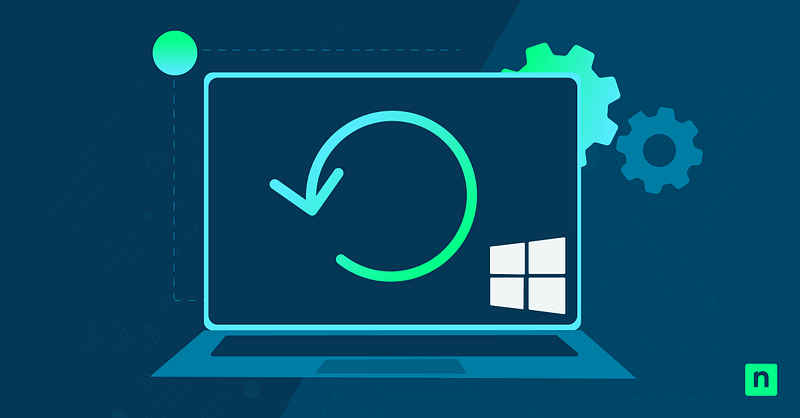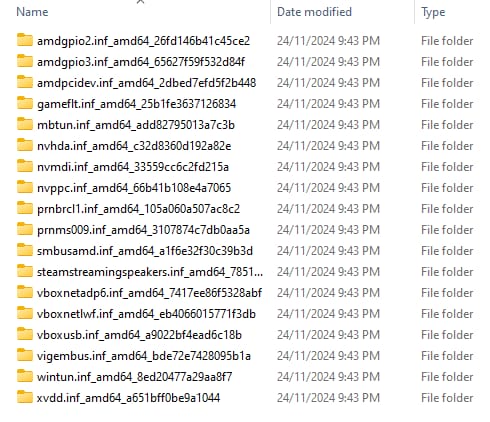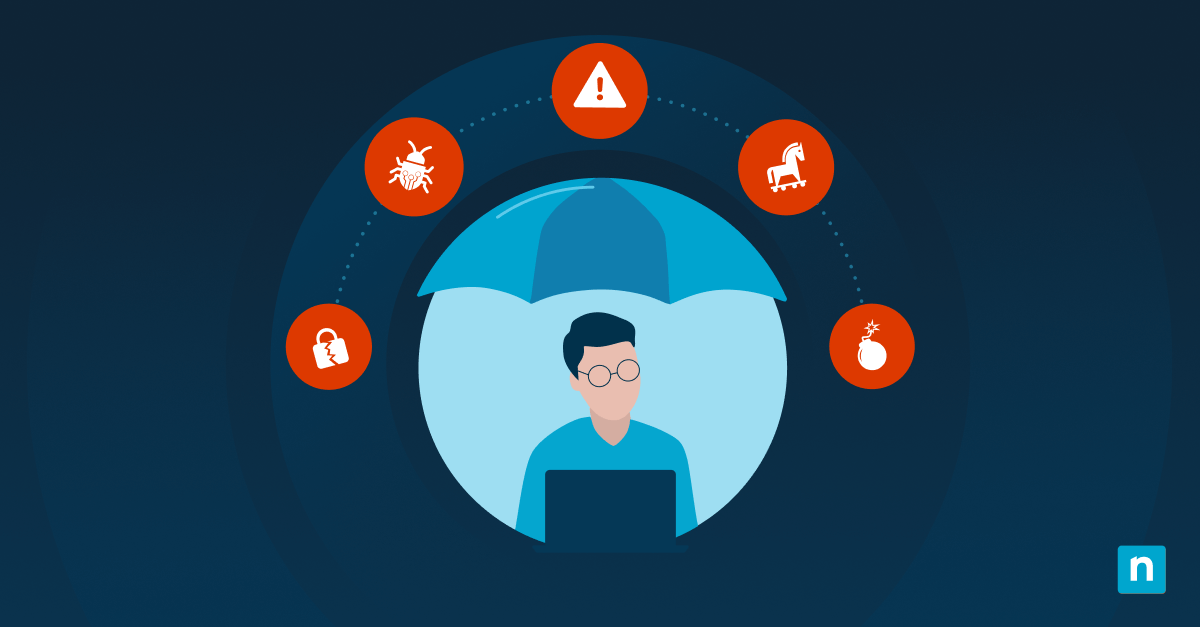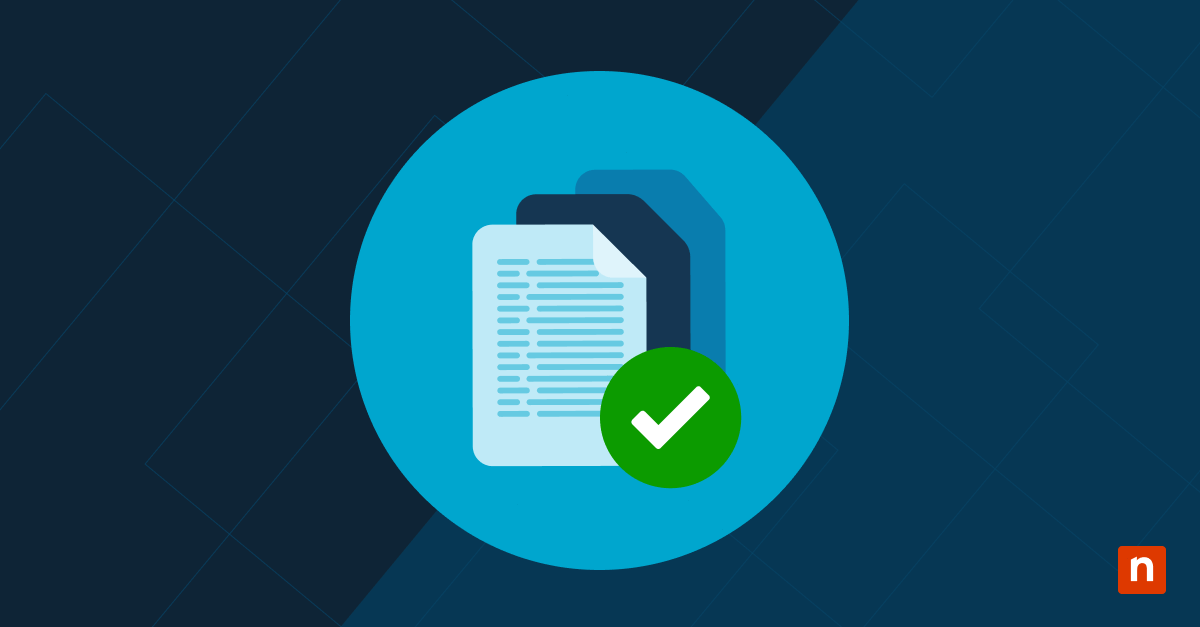Key Points
Why backup and restore Windows drivers?
Backup ensures recovery even when manufacturer drivers disappear or Windows Update lags—essential for older or unsupported hardware and system recovery scenarios
How to Backup and Restore Device Drivers in Windows 11 and Windows 10
- Run all driver backup/restore commands from an elevated PowerShell or Command Prompt as Administrator.
- Do a full system backup before restoring drivers
Backup Methods:
- Using DISM via Powershell or Command Prompt: Enter this code: dism /online /export-driver /destination:”DESTINATION_PATH.
- Using PnPUtil via Powershell or Command Prompt: Enter this code: dism /online /export-driver /destination:”DESTINATION_PATH
- Using Export-WindowsDriver via PowerShell: Enter this cmdlet: Export‑WindowsDriver -Online -Destination “DESTINATION_PATH”
Restore Methods:
- Using Device Manager (single device):
- Update driver.
- Click “Browse my computer for drivers”.
- Check the box “Include subfolders”.
- Using Device Manager (all devices):
- Repeat steps above.
- Click on Actions and select “Add drivers”.
- Check the box “Include subfolders”.
- Click “Browse”, then check the “Include subfolders” box.
- PnPUtil bulk restore: Enter this cmdlet: pnputil /add-driver “DRIVER_BACKUP_PATH\*.inf” /subdirs /install /reboot
Verifying Restored Drivers:
Use pnputil /enum-drivers to list installed drivers and confirm successful restores.
This detailed step-by-step tutorial demonstrates how to back up and restore device drivers on Windows 11 and Windows 10 PCs.
Backing up your device drivers will save you a great deal of time whenever you need to reinstall Windows, especially for custom-built devices where you need to install drivers for each device. Exporting third‑party Windows drivers speeds up the installation. In addition, if you no longer have access to the original drivers from the manufacturer, you’ll still have the installation packages ready to go. Restoring drivers from a backup can also make troubleshooting and recovering from major system problems less stressful.
What are device drivers, and why are they important?
Device drivers are the software that interact with the hardware in your computer. The driver provides the means for your operating system to ‘talk’ to the underlying hardware. For example, the driver for a USB Wi-Fi adapter provides Windows with the information it requires to interact with the physical USB device, allowing it to control the wireless hardware to connect to networks.
Device drivers are not unique to Windows, and every operating system (including MacOS and Linux) uses drivers to communicate with the hardware they run on. Each operating system is written on separate drivers.
Windows ships with a large collection of drivers for common hardware to get you up and running, and more up-to-date drivers for new devices are available online through Windows Update. Backing up third-party drivers in Windows 10 and 11 ensures that you always have access to these drivers in the event that they’re no longer available. Windows can also lag behind when it comes to updates third-party drivers so exporting third‑party Windows drivers allows you to install the latest versions.
Installing up-to-date drivers is necessary to troubleshoot system issues (including instability), improve performance (especially in the case of graphics drivers, which are regularly optimized for the latest games), and resolve known security issues (for example, a bug in a driver tool that allows remote access).
Why backup and restore Windows drivers?
Backing up the drivers on a stable, working system is often overlooked but consistently backing up drivers can reduce downtime when something goes wrong.
Hardware manufacturers aren’t always great at keeping older versions of their drivers or drivers for older devices available online. This becomes a problem when you want to reinstall Windows on an older device or require a specific version of a driver for compatibility reasons.
While there are websites that offer catalogs of legacy drivers from different manufacturers, these are often infected with malware which can compromise your files and systems. By backing up your working drivers yourself, you can make sure you can always restore your system and continue using the hardware you need, even if you lose the driver disk or the manufacturer becomes defunct.
Even if you don’t plan on re-installing Windows, having back up copies of your drive minimizes downtime caused by outages, system issues or malware attacks.
Preparing for driver backup and restore in Windows
Before you run any of the commands to backup and restore device drivers, make sure you’re logged in as an Administrator. All commands should be run in an administrative Command Prompt or PowerShell session.
On Windows 11, you can open PowerShell as an administrator by right-clicking on the Start button and selecting Terminal (Admin). On Windows 10, click PowerShell (Admin) instead.
If you’re restoring drivers, you should take a full backup of your Windows device before you restore any drivers, just in case something goes wrong and you need to restore your whole system to its previous state.
Step-by-step guide to backup device drivers in Windows
Method 1: Using the DISM tool (Command Prompt/PowerShell)
The first way you can backup all of your device drivers in Windows 11 or Windows 10 is to use the DISM (Deployment Image Servicing and Management) command line tool. The DISM can only be used to export drivers for third-party applications.
The following command will back up all installed device drivers to the DESTINATION_PATH (for example: D:\DRIVER_BACKUPS):
dism /online /export-driver /destination:”DESTINATION_PATH”
Note that the destination path must be created before running this command.
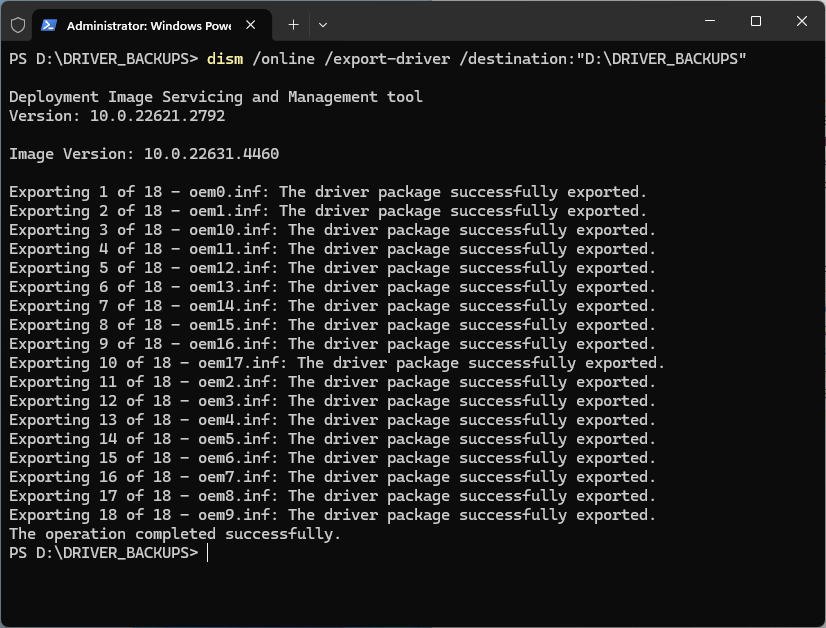
Within the destination folder, a folder will be created for each exported driver:
Within each folder will be the driver files themselves:
The DISM tool is included with all versions of Windows 11 and Windows 10.
Method 2: Using PnPUtil (Command Prompt/PowerShell)
The PnPUtil program, or pnputil.exe, is included with Windows 11 and Windows 10, and can be used to backup device drivers.
However, PnPUtil only works when Windows is running and cannot add or install drivers into a system image that’s offline or not currently booted.
In addition, pnputil does not backup the .pnf files for drivers like DISM does. This can lead to issues such as Device Manager failing to load drivers.
Follow these steps to backup drivers using PnPUtil:
pnputil /export-driver * “DESTINATION_PATH”
Note that the destination path must be created before running this command.
Method 3: Using Export-WindowsDriver (PowerShell)
The Export-WindowsDriver PowerShell cmdlet is part of the DISM tool. Similar to the DISM tool, this method only works for third-party drivers and not Microsoft-provided drivers. Using this commandlet allows you to an be used to export/backup your device drivers using the following command:
Export-WindowsDriver -Online -Destination “DESTINATION_PATH”
How to restore device drivers in Windows
Restoring device drivers using the Device Manager
To restore the driver for only a specific device using the Device Manager, follow these steps:
- Right-click on the Start button
- Click on Device Manager
- Locate the device you want to restore the driver for in the list
- Right-click on the device and select Update driver
- Click Browse my computer for drivers when asked How do you want to search for drivers?
- When asked to Browse for drivers on your computer, click the Browse button and navigate to your driver backup directory
- Check the box Include subfolders and then click Next
- Device Manager will now install any drivers from the backup directory that are more recent than those already installed
To restore drivers for all devices from a directory using the Device Manager:
- Repeat the steps above to open the Device Manager
- Click on Actions in the Device Manager menu bar and select Add drivers
- When prompted to Choose a location to search for drivers, click the Browse button and select the path to the folder containing your driver backups
- Check Include subfolders and click Next
- The Device Manager will then search for and install all drivers it finds in the specified directory
Restoring all device drivers using pnputil
PnPUtil can be used to restore all drivers from a specified directory by running:
pnputil /add-driver “DRIVER_BACKUP_PATH\*.inf” /subdirs /install /reboot
This will search the specified DRIVER_BACKUP_PATH for drivers, install any it finds in that folder or its subdirectories, and then reboot your system.
How to verify restored drivers
The PnPUtil command can also be used to confirm that your drivers have been successfully installed/restored by listing all the drivers that are installed in the Windows driver store:
pnputil /enum-drivers
Best practices and troubleshooting Windows driver backup and restore
There are a few best practices you can follow to ensure backing up and restoring drivers goes smoothly, and to troubleshoot any issues you encounter:
- Back up your drivers regularly: When your drivers and operating system are updated, create backup copies so you have a known working set of drivers that is compatible with the latest version of Windows. For IT teams, utilizing backup software allows you to automate scheduled backups, ensuring that third-party.
- Keep a backup audit log: Record the date backups were taken and, ideally the version of Windows they were taken for.
- Always try to use the latest drivers: Unless there is a specific compatibility issue, stick to the latest versions of drivers made by your device manufacturer for the best compatibility and performance.
- Do not try to restore multiple versions of the same driver: Organize your backups to avoid having multiple versions of the same driver in a directory.
If at any point a device stops working, check the vendor for a new release for the driver. It’s possible an update is required for compatibility with a recent Windows update or to resolve a conflict with another system component.
This step-by-step guide makes maintenance easy – watch how to backup & restore windows device drivers.
Backing up, restoring, and managing device drivers for fleets of Windows PCs
If you’re backing up and restoring device drivers on a single PC, it makes sense to use Windows’ built-in tools. While there are third-party tools available for home users, they may not be reputable, and are only replicating functionality that already exists in Windows 11 and Windows 10.
Maintaining your own library of drivers for your fleet is vital in IT operations, especially for devices that are no longer supported — an infected driver from a third-party source is a nightmare for an individual, and could seriously threaten business continuity if deployed to multiple devices in an enterprise environment.
Endpoint management by NinjaOne lets you leverage Windows’ built-in tools to backup and restore device drivers for fleets of PCs by creating and deploying PowerShell scripts. You can also monitor for driver issues and restore from known working drivers that were previously archived, all from a unified web interface for devices located anywhere in the world.

